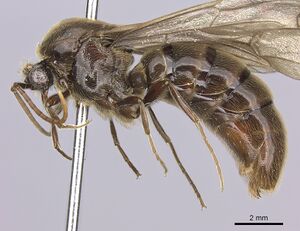Neivamyrmex impudens
| Neivamyrmex impudens | |
|---|---|

| |
| Scientific classification | |
| Kingdom: | Animalia |
| Phylum: | Arthropoda |
| Class: | Insecta |
| Order: | Hymenoptera |
| Family: | Formicidae |
| Subfamily: | Dorylinae |
| Genus: | Neivamyrmex |
| Species: | N. impudens |
| Binomial name | |
| Neivamyrmex impudens (Mann, 1922) | |
This species is only known from queens and/or workers and has yet to be associated with males.
Identification
Posterior face of propodeum straight, not concave, shorter than dorsal face; eye with distinct convex cornea; color light red brown; promesosomal dorsum relatively arched, not in same plane as dorsal face of propodeum; anteroventral petiolar margin with sharp recurved tooth.
This species is a nocturnal version of Neivamyrmex swainsonii (as Neivamyrmex pilosus mexicanus). Males and workers have similar morphology.
Distribution
Latitudinal Distribution Pattern
Latitudinal Range: 21.2166° to 15.4°.
| North Temperate |
North Subtropical |
Tropical | South Subtropical |
South Temperate |
- Source: AntMaps
Distribution based on Regional Taxon Lists
Neotropical Region: Costa Rica, Guatemala, Honduras (type locality), Mexico.
Distribution based on AntMaps
Distribution based on AntWeb specimens
Check data from AntWeb
Countries Occupied
| Number of countries occupied by this species based on AntWiki Regional Taxon Lists. In general, fewer countries occupied indicates a narrower range, while more countries indicates a more widespread species. |

|
Estimated Abundance
| Relative abundance based on number of AntMaps records per species (this species within the purple bar). Fewer records (to the left) indicates a less abundant/encountered species while more records (to the right) indicates more abundant/encountered species. |

|
Biology
Jack Longino: I know this species from multiple collections of nocturnal columns. One observation at La Selva Biological Station was a very fast, tight column running with brood. The exposed part of the column was 10-20m long. It emerged from a simple hole in ground under leaf litter, at which point there was a large pile of brood. Workers were transporting this brood 10-20m to a point between two buttresses, where they disappeared into a simple hole. A second observation at La Selva was also a rapid, dense column. It was crossing the trail to river station near the Sura at 2300hrs. The column was descending from as high as I could see in the vegetation on one side, crossing the trail, and ascending into the vegetation on the other side. The steady stream of workers never diminished during the half hour I watched. None of the workers appeared to be carrying anything substantial, although I occasionally saw one with a tiny white object, perhaps an egg or small larva. Some workers were uniformly reddish, but others were reddish with contrasting bright yellow abdomens.
Association with Other Organisms
 Explore: Show all Associate data or Search these data. See also a list of all data tables or learn how data is managed.
Explore: Show all Associate data or Search these data. See also a list of all data tables or learn how data is managed.
- This species is a associate (details unknown) for the phorid fly Ecitophora costaricensis (a associate (details unknown)) (Quevillon, 2018).
Castes
    
| |
| . | |
Nomenclature
The following information is derived from Barry Bolton's Online Catalogue of the Ants of the World.
- impudens. Eciton (Acamatus) impudens Mann, 1922: 19, fig. 9 (w.) HONDURAS.
- Type-material: syntype workers (number not stated).
- Type-locality: Honduras: Progresso, ii.-iii.1920 (W.M. Mann).
- Type-depositories: MCZC, MSNG, MZSP, USNM.
- Combination in Neivamyrmex: Borgmeier, 1953: 10.
- Status as species: Borgmeier, 1939: 413; Borgmeier, 1955: 381 (redescription); Kempf, 1972a: 155; Watkins, 1976: 16 (in key); Watkins, 1982: 211 (in key); Bolton, 1995b: 289; Branstetter & Sáenz, 2012: 254.
- Distribution: Costa Rica, Guatemala, Honduras, Mexico.
Taxonomic Notes
Jack Longino: Borgmeier (1955) speculated that Neivamyrmex longiscapus, known only from males, might be the male of N. impudens. CO1 (DNA barcode) sequence data (courtesy Alex Smith and BOLD) confirm that N. impudens workers and N. longiscapus males from a site in Guatemala are the same. I now consider N. longiscapus a junior synonym of N. impudens and have changed my specimen database accordingly.
Description
References
- Borgmeier, T. 1953. Vorarbeiten zu einer Revision der neotropischen Wanderameisen. Stud. Entomol. 2: 1-51 (page 10, Combination in Neivamyrmex)
- Borgmeier, T. 1955. Die Wanderameisen der neotropischen Region. Stud. Entomol. 3: 1-720 (page 381, see also)
- Borowiec, M.L. 2019. Convergent evolution of the army ant syndrome and congruence in big-data phylogenetics. Systematic Biology 68, 642–656 (doi:10.1093/sysbio/syy088).
- Mann, W. M. 1922. Ants from Honduras and Guatemala. Proc. U. S. Natl. Mus. 61: 1-54 (page 19, fig. 9 worker described)
- Varela-Hernández, F., Medel-Zosayas, B., Martínez-Luque, E.O., Jones, R.W., De la Mora, A. 2020. Biodiversity in central Mexico: Assessment of ants in a convergent region. Southwestern Entomologist 454: 673-686.
References based on Global Ant Biodiversity Informatics
- Borgmeier T. 1955. Die Wanderameisen der neotropischen Region. Studia Entomologica 3: 1-720.
- Dattilo W. et al. 2019. MEXICO ANTS: incidence and abundance along the Nearctic-Neotropical interface. Ecology https://doi.org/10.1002/ecy.2944
- Fernandes, P.R. XXXX. Los hormigas del suelo en Mexico: Diversidad, distribucion e importancia (Hymenoptera: Formicidae).
- Kempf, W.W. 1972. Catalago abreviado das formigas da regiao Neotropical (Hym. Formicidae) Studia Entomologica 15(1-4).
- Longino J. T. 2013. Ants of Nicargua. Consulted on 18 Jan 2013. https://sites.google.com/site/longinollama/reports/ants-of-nicaragua
- Longino J. T., J. Coddington, and R. K. Colwell. 2002. The ant fauna of a tropical rain forest: estimating species richness three different ways. Ecology 83: 689-702.
- Longino J. et al. ADMAC project. Accessed on March 24th 2017 at https://sites.google.com/site/admacsite/
- Quiroz-Robledo, L.N. and J. Valenzuela-Gonzalez. 2006. Las hormigas Ecitoninae (Hymenoptera: Formicidae) de Morelos, México. Revista Biologia Tropical 54(2):531-552
- Vásquez-Bolaños M. 2011. Lista de especies de hormigas (Hymenoptera: Formicidae) para México. Dugesiana 18: 95-133
- Watkins II, J.F. 1982.The army ants of Mexico (Hymenoptera: Formicidae: Ecitoninae). Journal of the Kansas Entomological Society 55(2): 197-247.

